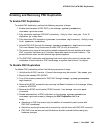
ATM PNC-DUP (ATM PNC Duplication)
Issue 1 June 2005 595
● The global refresh from releasing the standby PNC has completed.
● The standby PNC’s state of health surpasses the active PNC’s.
At this point, the faulty component is on the standby PNC, and the PNCs are locked in their
current active/standby state.
3. Busyout the PNC with busyout pnc.
4. Use fault isolation and component testing procedures for the individual PNC components,
just as for a simplex PNC. Replacement of components does disrupt operation of the active
PNC.
5. Once the failed component is replaced, use status pnc to check the health standby PNC
component.
6. When confident that the problem has been resolved, as indicated by an all-zero state of
health, unlock (set pnc unlock) and release (release pnc) the PNC. Note that no
further PNC interchange is required since you can test the standby PNC as thoroughly as
the active.
Interactions: Server Resets and PNC Interchanges
● A system reset of level 1 (warm), 2 (cold2) or 4 (reboot) does not change which PNC is
active. If a PNC interchange was in progress when the reset took place, the PNC
interchange continued until completion.
● If a reset system 1 (warm) takes place during a PNC interchange, the reset is
escalated to level 2 (cold2).
Fault Isolation Using Duplicated PNC
In some cases, PNC duplication can aid in the fault isolation procedure. PNC interchanges can
be used to help isolate the faulty hardware. Two examples demonstrating this technique follow:
1. There is a fault that can occur in either an IPSI connected PN’s ATM-EI or the PKT-INT
which cannot be readily attributed to one board or the other. If the packet bus transceivers
on either the PKT-INT or ATM-EI fail, the two boards cannot communicate, but it will not be
clear which board is at fault. In this case, a planned interchange of the PNC can be used to
indicate which of the two boards. If the interchange:
- Cures the problem, the ATM-EI was at fault
- Does not cure the problem, the PKT-INT is suspect (provided there are no PKT-BUS
faults)
2. A similar relationship exists for the PN Archangel (EAA - the active ATM-EI) and certain
TDM-bus problems. If the EAA is unable to communicate with a port board over the TDM
bus, either the EAA has a fault, the port board has a fault, or there is a problem with the


















